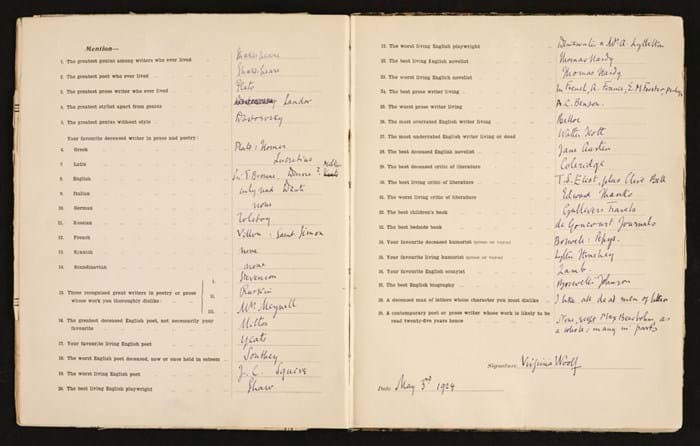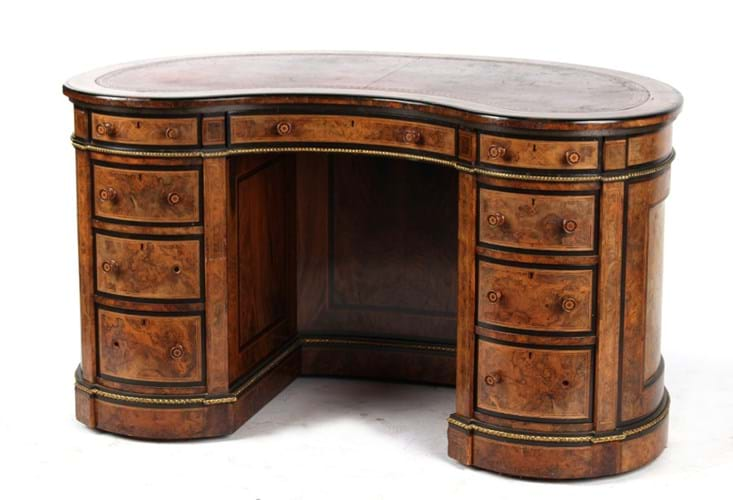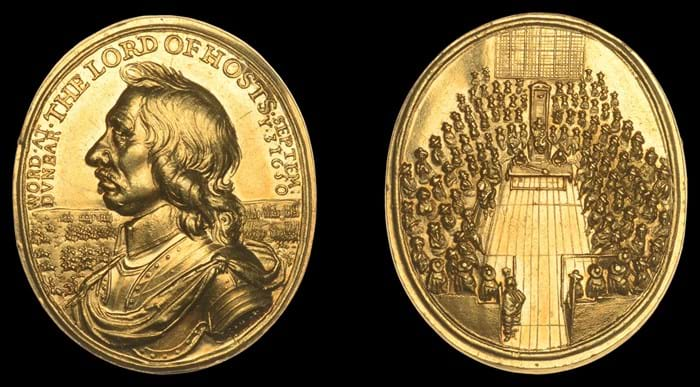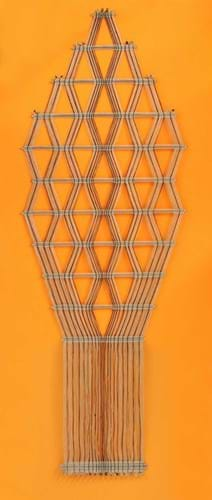1. Victorian kidney-shaped desk – £14,000
Victorian kidney-shape desks remain hugely popular pieces of furniture. This example, shown above, offered by Semley Auctions in Shaftesbury on January 23 as ‘the property of a lady’ was particularly fine.
Made in burr walnut and tulipwood, it is mounted in ormolu and delicately inlaid to the drawer fronts with boxwood lines and to the drawer pulls with marquetry floral medallions.
It measures 4ft 4in (1.32m) wide. Offered with a very appealing guide of £1500-2500, the hammer price was £14,000.
2. Cromwellian gold medal – £16,000
This small oval gold medal was struck at the end of 1650 to mark the victory of the New Model Army at the Battle of Dunbar.
To one side is the bust of Oliver Cromwell with a battle scene in the background and the words Lord of Hosts Dvnbar Septem y 3 1650. To the other is a view of the Long Parliament – a scene that also appears on a Cromwellian naval award.
The medal is one of the many creations of Thomas Simon (c.1623-65), the chief engraver to the Mint who prepared the dies for the Commonwealth coinage.
Dunbar medals are very rare: just one each are known in silver, copper, pewter and alloy, and three in gold. This particular example, deemed ‘extremely fine’ has a provenance back to the sale of the Earl of Pembroke collection at Sotheby in 1848.
It was one of the many outstanding coins and medals from the Interregnum offered by Dix Noonan Webb on January 21 during the fourth and final part of the so-called North Yorkshire Moors collection. The collection had been amassed by Marvin Lessen, an American working in the aerospace and defence industries who began seriously collecting British coins after moving to Scarborough in 1962.
Estimated at £10,000-15,000, it sold at £16,000.
The Battle of Dunbar was fought between the New Model Army under Cromwell and a Scottish army commanded by David Leslie on September 3, 1650. It is considered the first major battle of the Third English Civil War which followed Scotland’s acceptance of Charles II as King after the regicide of Charles I. It was a decisive victory for Cromwell: in addition to the many killed and wounded at least half of the Scottish army of around 12,000 was taken prisoner.
3. Wycliffe’s New Testament – £12,000
Estimated at £3000-4000 at Forum Auctions in London on January 21, but sold at £12,000, was this rare first printed edition of Wycliffe's New Testament. With only 160 copies printed by Thomas Page in 1731 and just three copies recorded at auction, it ranks among the rarest of all English Bibles.
The full title is The New Testament of Our Lord and Saviour Jesus Christ Translated out of the Latin Vulgat by John Wiclif... , To which is praefixt A History of the Several Translations of the H. Bible and N. Testament, &c. into English... by John Lewis.
Wycliffe’s English translation of the Bible, completed in 1384 and revised around 1388, survived in manuscript form, but this was the first printed version prepared by John Lewis (1675-1747) based on two 15th-century manuscripts. Lewis provides an introduction discussing the history of English translations of the Bible and adds marginal notes to the text.
It was sold unbound for one guinea each to subscribers whose names (recorded in a list) included Sir Hans Sloane (1669-1735). This particular copy includes the mezzotint portraits of both Lewis and Wycliffe dressed in full regalia as Rector of Lutterworth that are lacking in most surviving versions.
4. Literary confessions book – £21,000

‘Really & Truly’, a book of literary likes and dislikes of several well-known authors, notably Virginia Woolf – £21,000 at Dominic Winter.
This book of literary confessions titled Really & Truly reveals the handwritten literary likes and dislikes of several well-known authors, notably Virginia Woolf, who has answered all 39 questions in her distinctive purple ink.
Among her mostly single-word answers to printed questions are: The best living English novelist: Thomas Hardy; The worst living English novelist: Thomas Hardy; The most underrated English writer living or dead: Walter Scott; A deceased man of letters whose character you most dislike: I like all dead men of letters.
Other English and Irish writers to complete the survey (the earliest dated December 1923, the last December 1927) include Rose Macaulay (1881-1958), Robert Lynd (1879-1949), Stella Benson (1892-1933), Margaret Irwin (1889-1967) and Margaret Kennedy (1896-1967).
The courtesy book was discovered among the effects of the owners' grandmother, the novelist Margaret Kennedy who appears as the last entry. It came for sale at Dominic Winter in South Cerney on January 21 with a guide of £4000-6000 but did rather better selling at £21,000.
5. Weaved ‘sculpture’ – £4600
Sworders’ 20th Century Design auction on January 26 included this 1980s ‘microgauze’ wall hanging by the British artist-weaver Peter Collingwood (1922-2008). The linen and steel rod ‘sculpture’ guided at £4000-6000 was the third the saleroom has offered in as many sales.
Two other similar lots were sold for strong prices in 2020: a weaving titled M.200. No.10 sold on behalf of a Suffolk client in May for £5800 and a larger hanging titled M.72 No.3 sold for £8000 in October for a consignor in North Carolina.
The latest Collingwood piece titled M143.74 dates from c.1988. It is sold with a facsimile of a letter dated March 24, 1989 explaining it was a gift to the recipients ‘John & Madoka’ from the Japanese weaver Jun Tomita (b.1951).
Collingwood apologies for a delay in sending it: “I am afraid I have taken rather a long time to get it woven as I have been travelling in India. There is a nylon loop at the top of the hanging – so it only needs one nail in the wall to hang it from.”
Courtesy of a postscript, the letter also sheds a little light on the numerical titles that Collingwood gave his works. He writes: “The metal label [impressed Paul Collingwood M143.74] shows it is design M143 & that it is the 74th time I have woven this design”.
The hammer price was £4600, in the middle of expectations.









